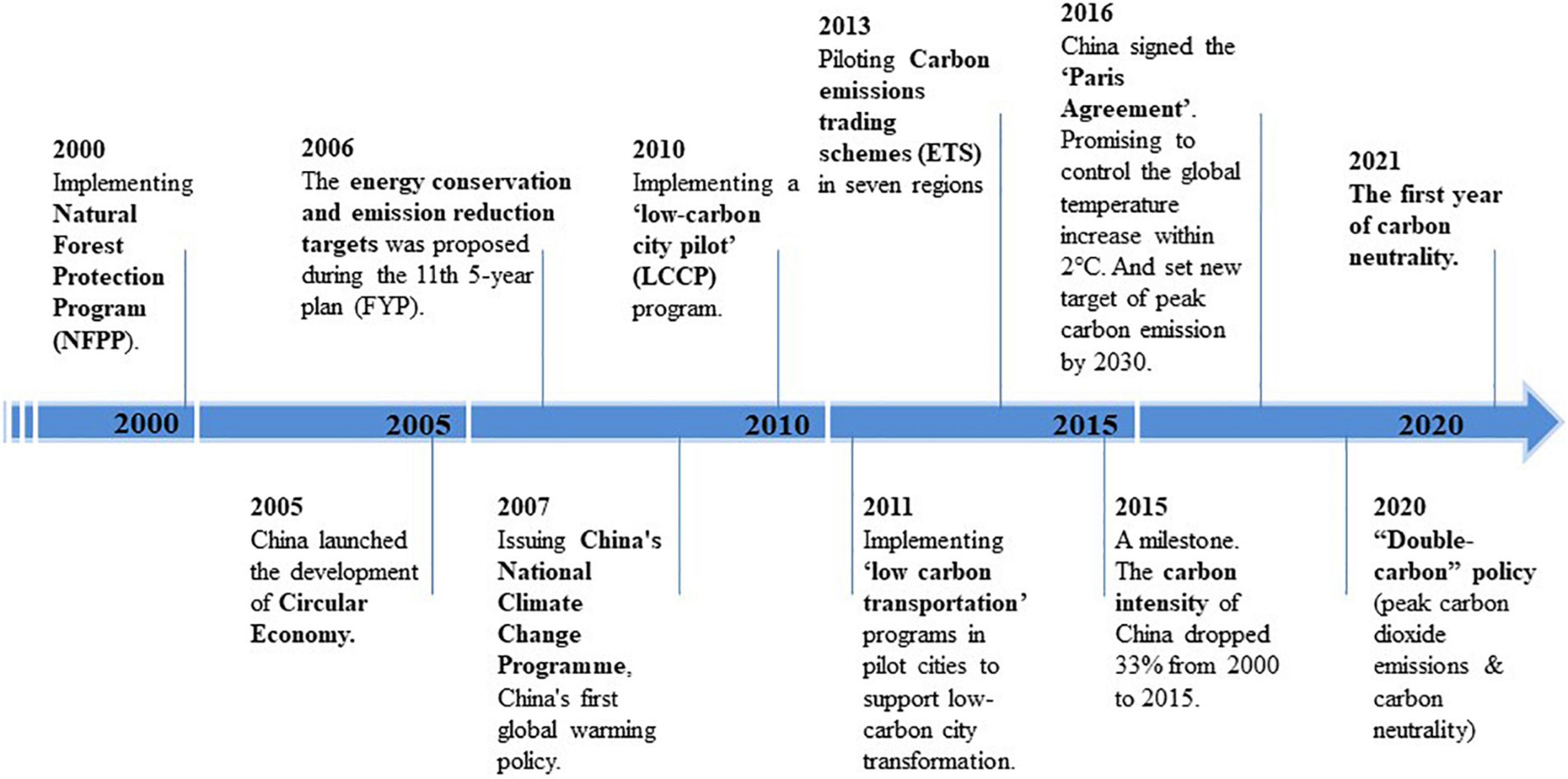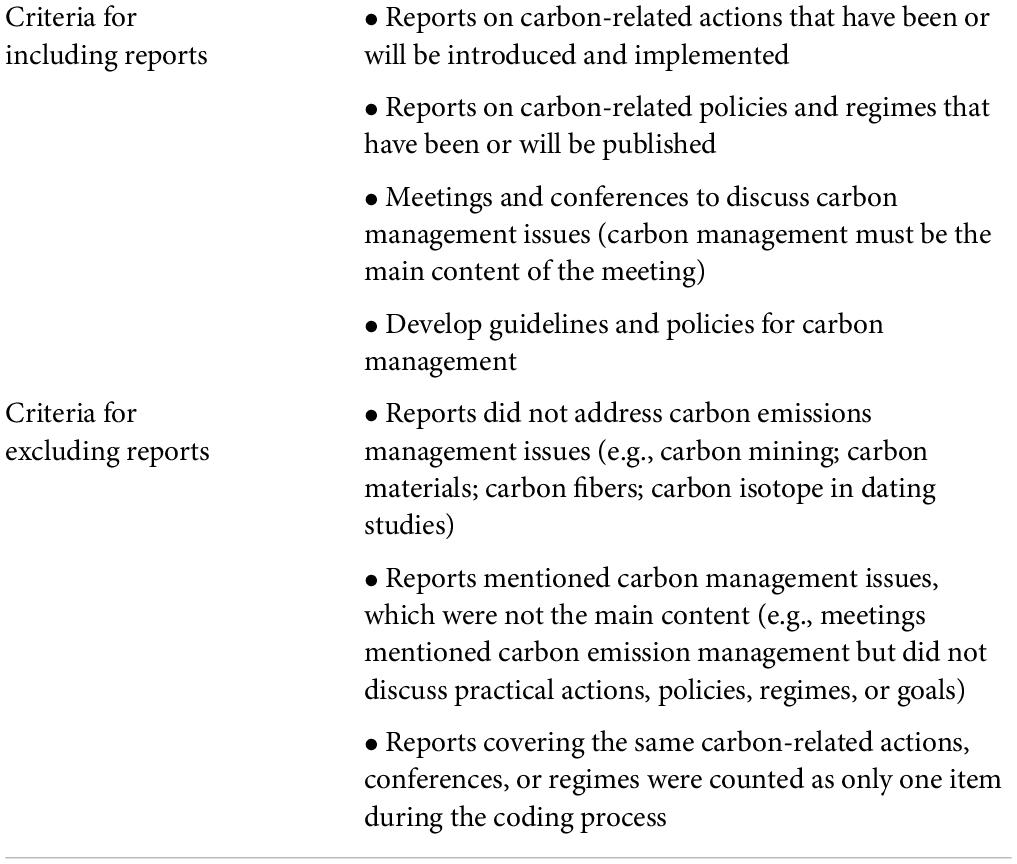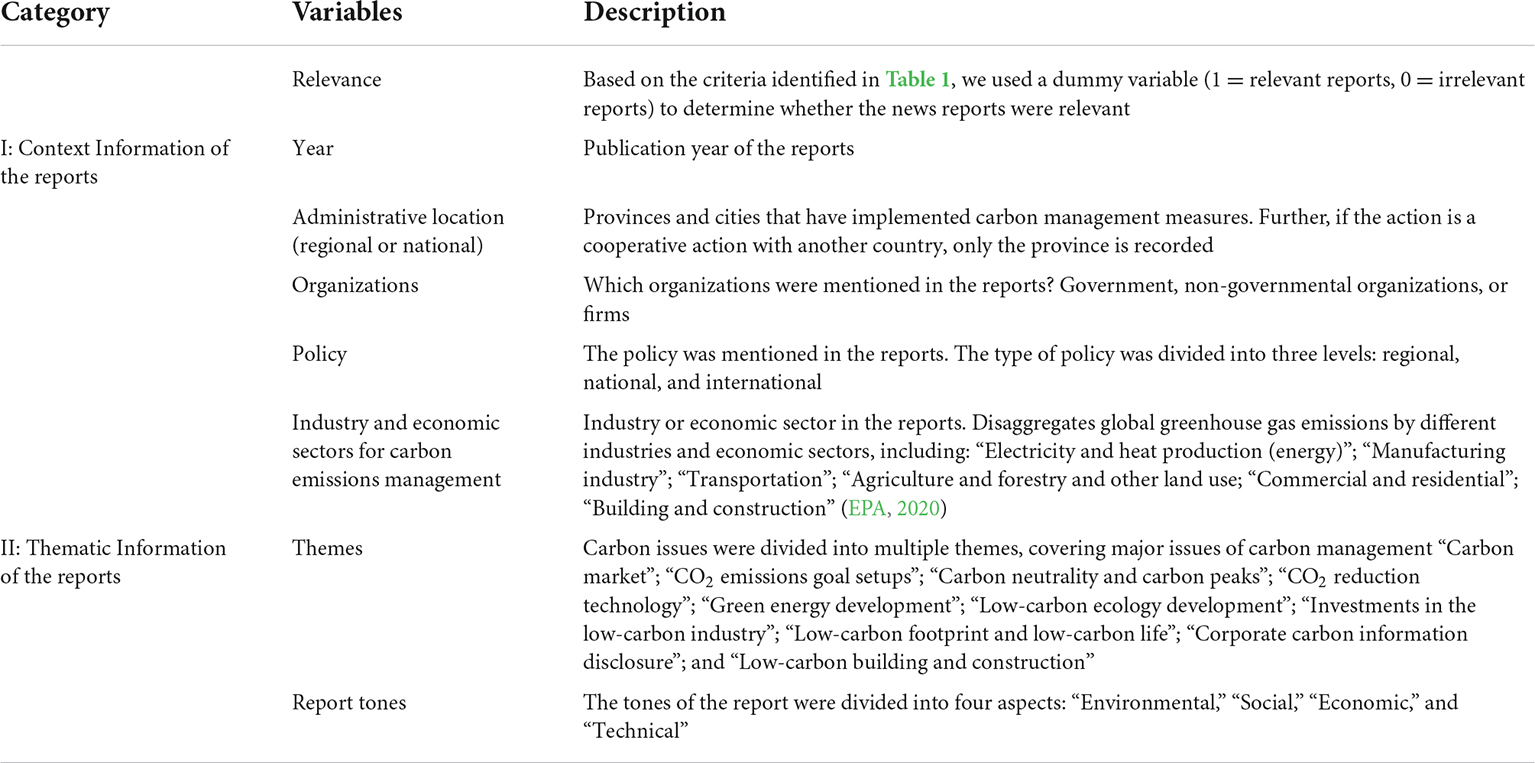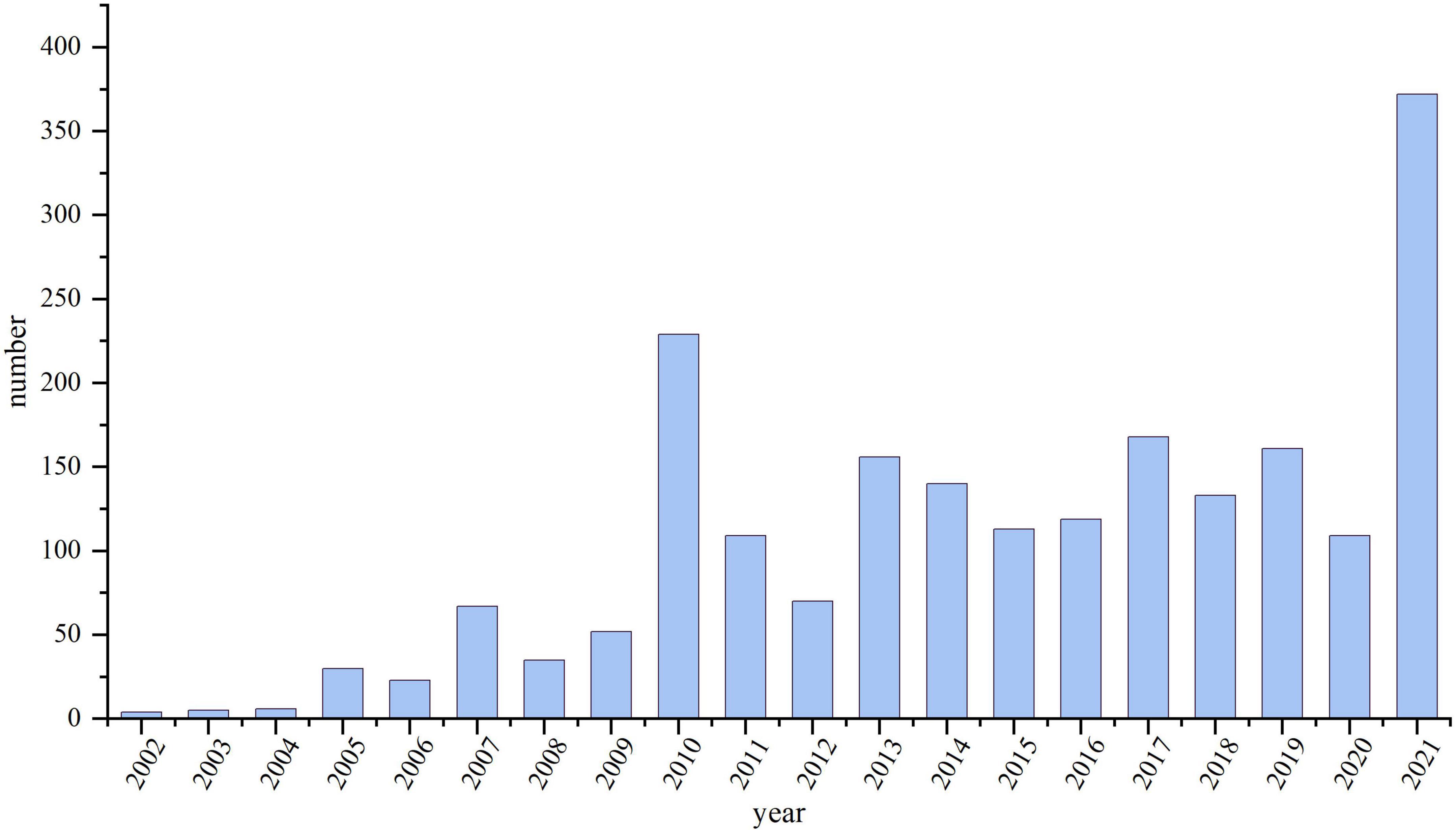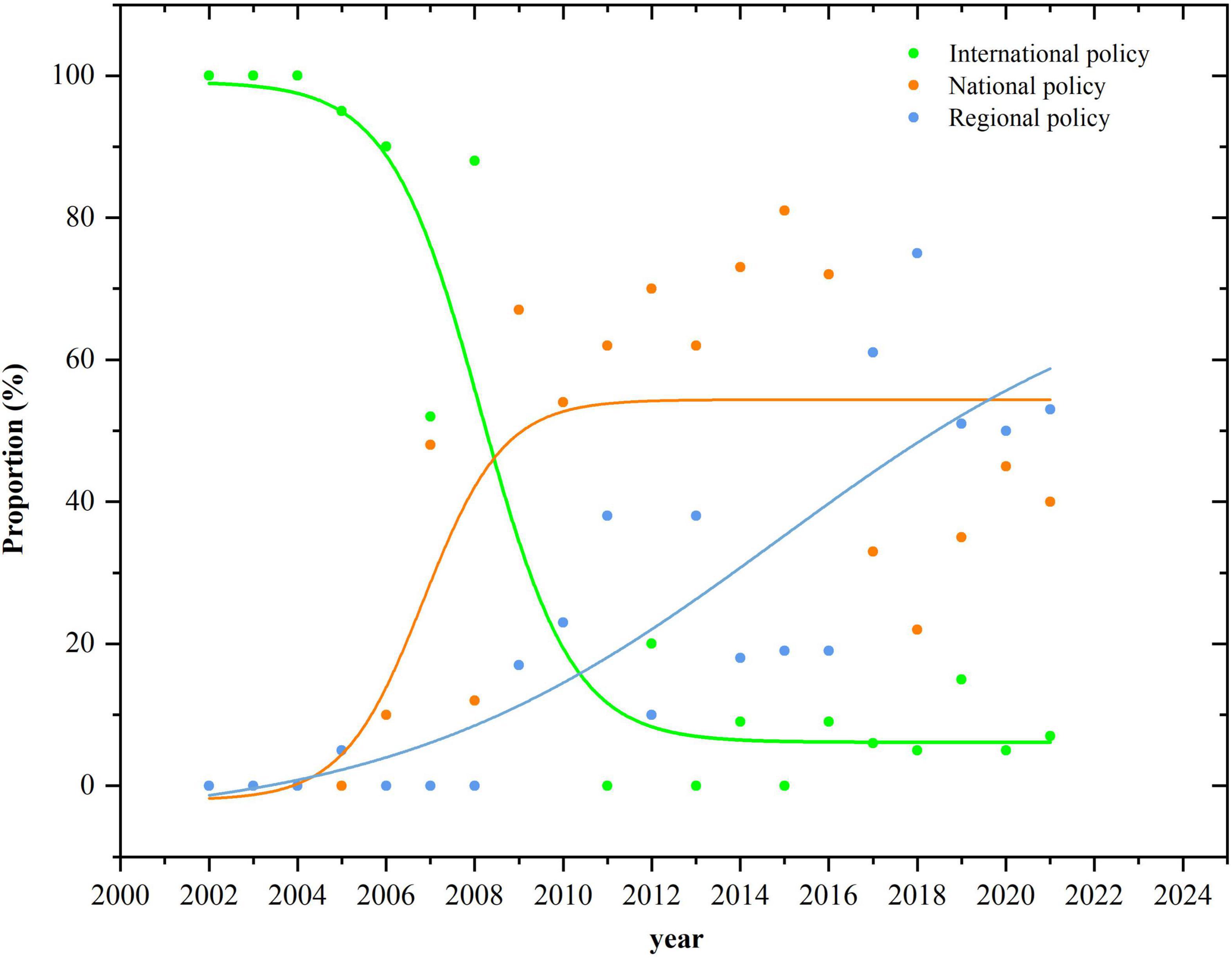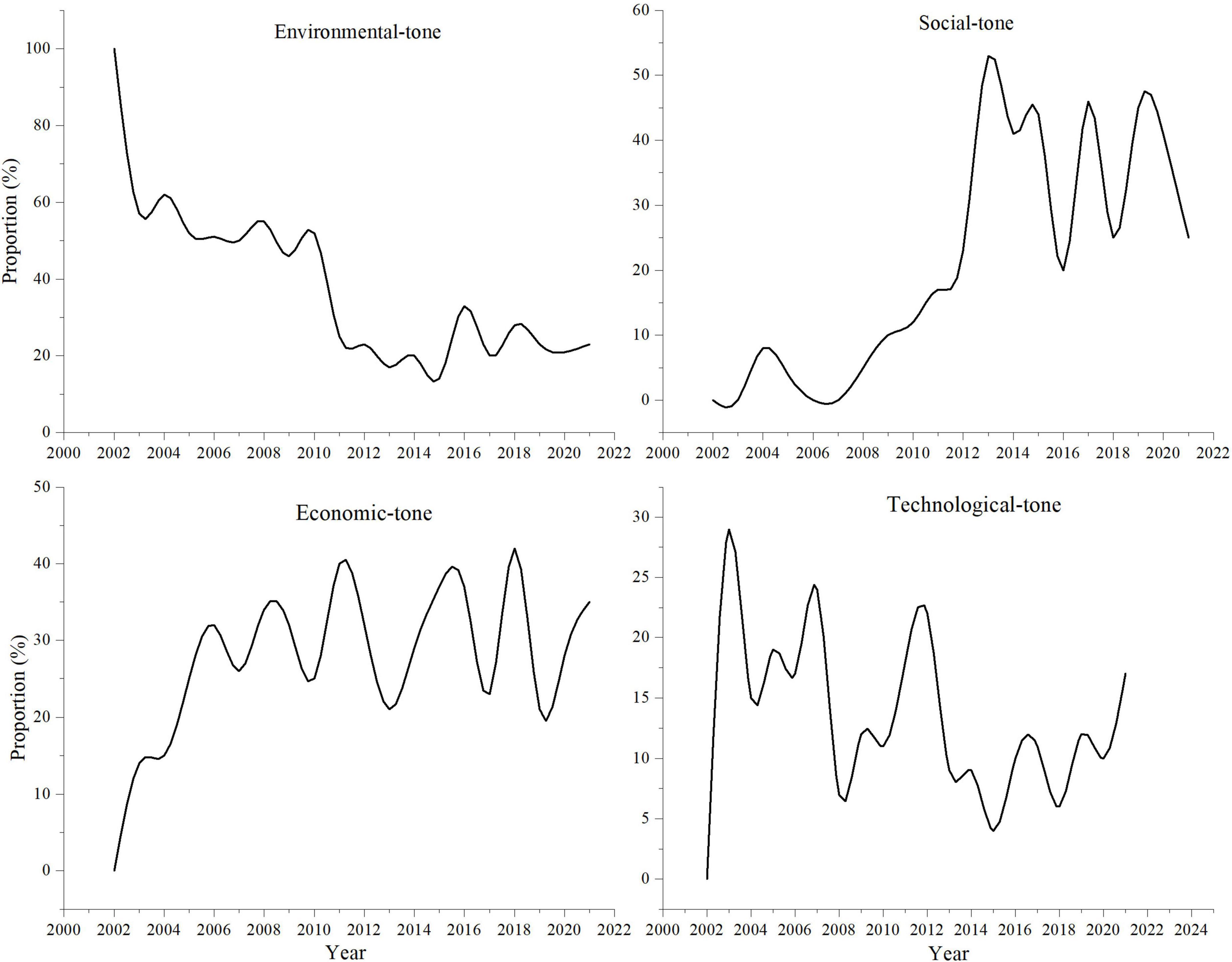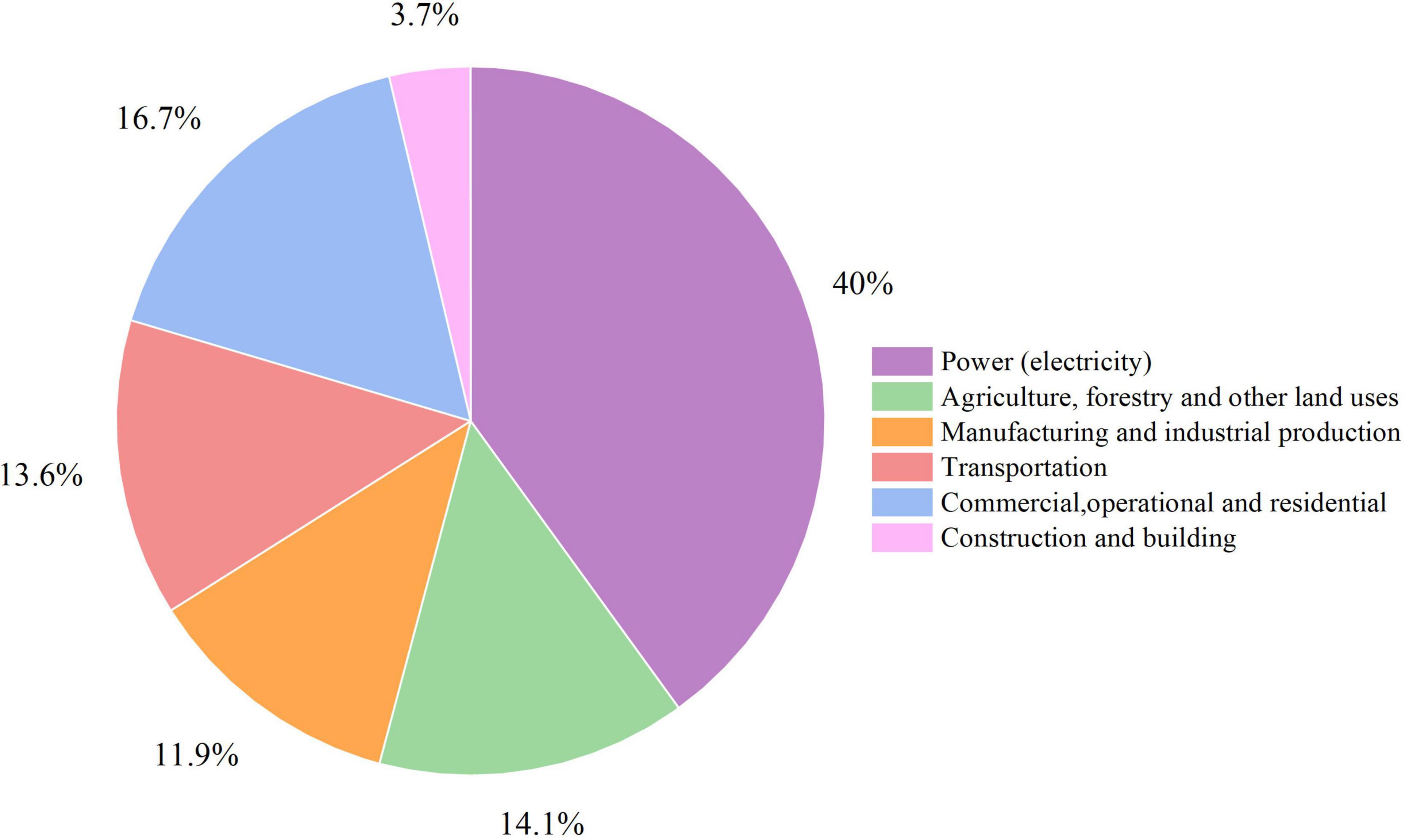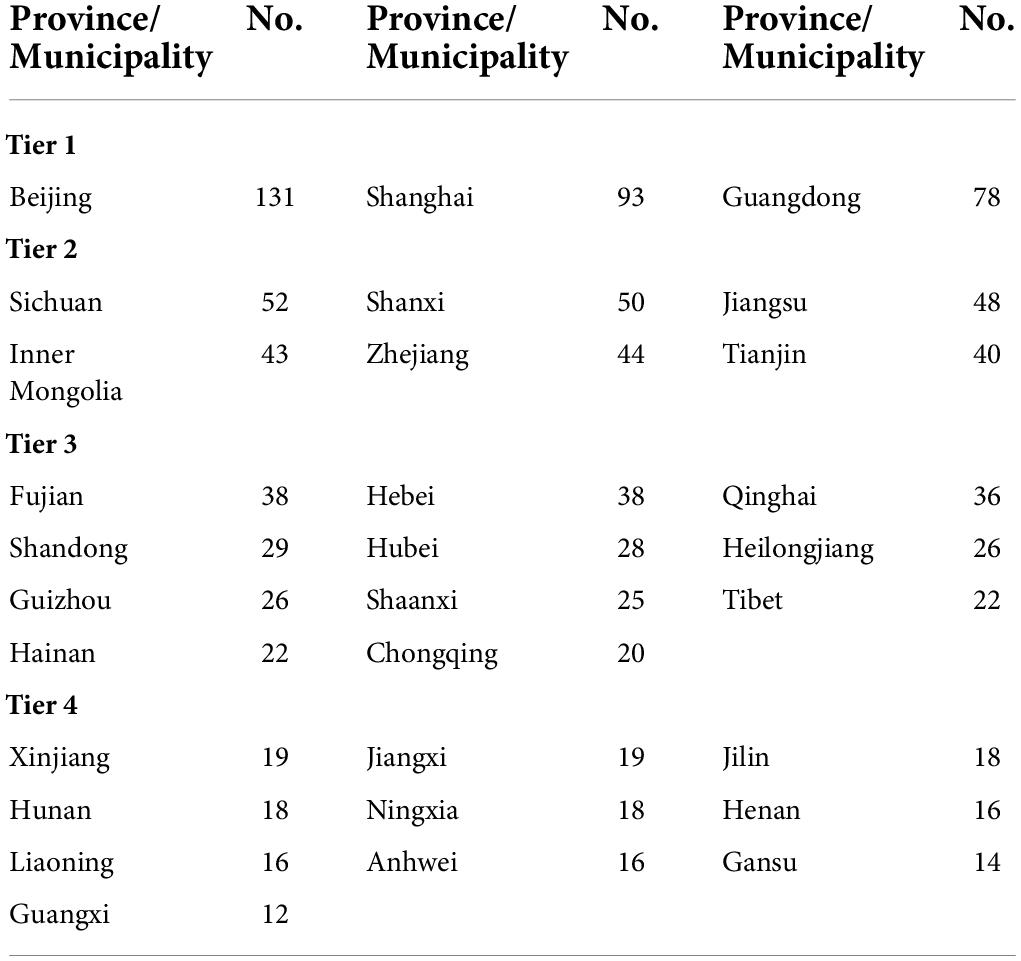- 1Business School, The University of Sydney, Darlington, NSW, Australia
- 2School of Earth and Environmental Science (SEES), The University of Queensland, Brisbane, QLD, Australia
- 3International Engineering and Technology Institute (IETI), Denver, CO, United States
- 4China Architecture Design & Research Group, Beijing, China
Over the past few decades, the carbon dioxide (CO2) emissions management problem has attracted global attention. China is transitioning to carbon neutrality and experienced rapid development in low-carbon management. However, current studies have limited understanding of the evolutionary process and development issues at a macro-level, which may hinder the structural reformation of stepwise carbon-neutral development. This study used the content analysis method to process and code reports from China’s most prominent news media, Xinhua News Agency, to identify China’s low-carbon evolution and development issues. The results depict a trend of gradually increasing carbon management within China and highlight the staged development features. Years 2010 and 2021 are the critical nodes of carbon emissions management in China, representing the two primary actions of low-carbon pilot city projects and the carbon-neutral construction. However, the results also reveal the uneven development problem of China’s carbon management behind the rapid transition. The government is the primary participant in carbon management, but the participation of firms and the public is relatively low. The power industry implements the highest amount of carbon management actions, but less attention is paid to other sectors with high carbon emissions. Report tones on environmental protection and green technology have gradually declined, while the tone on economic and social development has increased. There are evident differences in the number of carbon management measures implemented between regions. The southeast coastal regions report more management numbers than China’s central and western regions. The top three provinces (or municipalities) are Beijing (131), Shanghai (93), and Guangdong (78). From an industry perspective, more-reported regions have implemented carbon management measures in more industries than less-reported regions. This study provides a distinctive contribution to the theoretical work on China’s carbon emissions regulation and the emerging planning and management mechanisms.
Introduction
Over the past few decades, the carbon dioxide (CO2) emissions problem has attracted the attention worldwide. CO2 contributes to air pollution and is responsible for the energy imbalance in the atmosphere, causing the greenhouse effect and secondary issues such as natural disasters and severe weather (Nawaz et al., 2020; Umar et al., 2020). Therefore, reducing CO2 emissions has become a common target globally to alleviate the greenhouse effect and realize humankind’s sustainable development in the future. Countries worldwide have introduced carbon management policies and measures such as carbon emission reduction, new energy development, and carbon fixation technologies to reduce carbon emissions (Ducat and Silver, 2012; Zheng et al., 2021). Alternatively, some economists proposed to use economic tools, such as establishing carbon markets to limit and manage carbon emissions through carbon trading (Perdan and Azapagic, 2011; Weng and Xu, 2018). China is at the rapid development stage with increasing emerging markets and industries (Gao et al., 2022) and has a high carbon emission level. Hence, carbon management issues have received increasing attention in China, and theChinese Government set a clear commitment to reach the carbon peak in 2030 and achieve carbon neutrality by 2060 (Zhao et al., 2022). In this transition period, the Chinese Government has introduced and implemented diverse practices and trails to control carbon and issued a series of policies and actions to transit into a low-carbon society. These emerging practices include carbon emission reduction, low-carbon urban construction, green energy development, green transportation, carbon market, and carbon trading, and their practicability and effectiveness were also well studied (Zhang et al., 2016; Yang and Cheng, 2017; Hu et al., 2019; Umar et al., 2020; Wang K.-H. et al., 2021).
However, for such public policy development issues, little is known about the evolution process and potential development issues of China’s carbon management issues from a macro perspective. As China enters a new phase of carbon-neutral construction, the exploration from the macro perspective is necessaryto help analyze an issue’s temporal and spatial characteristics and changes and overcome conflicts between long-term goals and short-term concerns (Rotmans et al., 2001; Herold et al., 2003). Hence, understanding the evolutionary process of carbon management is urgently needed to spur sustainable development. For the societal study, media datasets are critical data sources that cannot be ignored. The news media, a precise source for recording time-definite information, helps provide necessary data for societal and evolutionary studies (Wei et al., 2017). The news media is one of the central explanatory systems in modern society, representing the views and attitudes of different groups, and has the power to create common knowledge and enhance public coordination (Potter, 2011). The media can reflect the Government’s values, attitudes, and opinions and official public opinion on environmental management issues (Kavanaugh et al., 2012), thereby reflecting the objective status, trends, and development characteristics of the issue. At the administrative level, China’s top-down regulation mechanism enables the Government to play a more dominant role in managing social and environmental public issues (Saravade et al., 2022). Therefore, the content expression of the mainstream media in China is likely to be very different from that of Western democracies. The state-owned nature of China’s mainstream media makes it a guidance for mainstream values and policies in mainland China (Wei et al., 2017), which reflects the implementation of local policies and their impact on the public. Such disparities pose opportunities for research on understanding China’s official responses to carbon issues and the potential problems within the development.
In this context, this study attempts to analyze the coverage of carbon issues by major Chinese news media through content analysis, providing new perspectives for understanding the evolution and potential development issues of carbon management in China. Through big data screening and analysis, the results reflect the long-term status of China’s carbon management development. In theory, this study provides a distinctive contribution to the studyof China’s carbon emissions regulation, emerging planning, and management mechanisms. Specifically, the objectives are screening and coding the primary variables of news reports and analyzing these variables temporally and spatially to identify the development trends and the unfairness within the management. The findings conclude the progress and deficiency of carbon management in China and assist carbon policymakers in improving management strategies to achieve carbon neutrality goals in the future. In addition, the findings from public news media reveal lessons on the carbon issue in China that might not emerge from other data sources.
The remaining content of the paper is structures as follows. Section “Background” provides a relevant background of China’s carbon management development and summarizes the milestones. Section “Materials and methods” presents the methodology for this study; Section “Results” demonstrates the results and interpretation. Section “Discussion” presents the discussion and the implication of the findings and sums up to conclude the paper.
Background
Development of the carbon emissions management in China
China is one of the largest carbon emitters, accounting for 28% of global carbon emission (Friedlingstein et al., 2020). Within these industries, manufacturing and industrial production contributes the largest proportion of CO2 emissions in China (50%), then follows the power industry contributes 40%. The transport industry occupied 8%, and the other industrial and economic sectors, including commercial, residential, agricultural, and building and construction, shared the rest (Sandalow, 2019).
As early as 2000, the Chinese Government decided to implement the Natural Forest Protection Program (NFPP) to enhance and protect the stability of the economy and the population’s livelihood (Qiao et al., 2021) and it has become one of the primary measures for carbon fixation after the carbon emission reduction target is proposed. In 2005, the Chinese Government launched the National Circular Economy pilot work to explore the valid mode of carbon emission reduction in critical areas and industries (Geng et al., 2013). Then, the Chinese Government first proposed energy conservation and emission reduction targets during the 11th 5-year plan (FYP) in 2006 to support the development of the Circular Economy (Yang et al., 2019). In addition, the Chinese Government is constantly improving carbon management laws. The National Development and Reform Commission (NDRC) issued China’s first global warming policy, China’s National Climate Change Program, in 2007. This program focuses on carbon emission governance and energy intensity in energy production and use, agriculture, forestry, and waste industries (Marks, 2010). In the following years, the Chinese government has successively introduced national policies related to carbon.
Meanwhile, the Chinese Government realized cities’ profound impact on CO2 emissions. Given China’s fast urbanization process and higher energy consumption than the rural areas, the NDRC initiated a low-carbon pilot city and province program in July of 2010 (also known as LCCP) to lead the transition of cities to a low-carbon development model (Khanna et al., 2014). The first five pilot provinces include Yunnan, Guangdong, Hubei, Shaanxi, and Liaoning provinces and the eight pilot cities include Tianjin, Baoding, Hangzhou, Chongqing, Nanchang, Guiyang, Xiamen, and Shenzhen (Wang et al., 2015). However, research assessments suggest that while pilot cities have made progress in carbon management planning, the complexity and confusion caused by multiple parallel plans and the lack of supportive policies and market support may hinder the realization of low-carbon cities (Khanna et al., 2014). Correspondingly, China’s Ministry of Transport launched a green transportation pilot project in 2011 to complement the construction of low-carbon cities. The project aims to promote the application of low-carbon transportation equipment by constructing low-carbon transportation infrastructures (Qu and Liu, 2016) and integrating the low-carbon concept into people’s lives. In addition, the Chinese government started to rely on market surveillance tools to achieve policy goals. For example, drawing on the experience of foreign carbon market construction, China’s National Development and Reform Commission implemented an Emissions Trading Scheme (ETS) in seven pilot regions in 2013, and all of them started operation in 2014 (Munnings et al., 2016). Although the carbon trading outcomes are suboptimal due to the inadequate scheme design, the experience of establishing and operating the pilot systems is valuable. The empirical study showed that China’s carbon intensity declined by 33% from 2000 to 2015, which is mainly attributed to the progress made by these carbon management projects, especially the improvement of industrial energy efficiency contributed the most to the reduction of emissions (Liu et al., 2019).
Internationally, the Chinese Government has actively participated in global carbon reduction conferences and activities in recent years. In 2016, China signed the Paris Agreement with 180 countries worldwide, aiming to limit the global average temperature rise to 2 or 1.5°C by the end of this century. To achieve a low-carbon society earlier, China committed to achieving peak CO2 emissions around 2030 and enlarging carbon intensity reduction by 65% from the 2005 level (Zhou et al., 2021). Based on the peak carbon emission target, China proposed a new goal in 2020: to achieve carbon neutrality by 2060 (Mallapaty, 2020). This goal reflects the determination of China to tackle climate change, and it also poses challenges to China’s development. In summary, China’s major carbon management actions are listed in the timeline below (Figure 1).
Existing challenges in carbon emissions management in china
However, China still faces many challenges from peak carbon to carbon neutrality in the transition period. (1) China’s carbon emission continues to increase, while its carbon emission may not reach its peak in the short term; (2) China relies heavily on fossil energy (up to 85%) to maintain its rapid development, with significant energy consumption and low efficiency; (3) China’s economic development level is relatively lower than developed countries, making it weak to resist economic risks; (4) low-carbon and renewable energy technologies are immature; (5) promoting regional low-carbon emissions and a national “green market” remains an important challenge in realizing a comprehensive low-carbon society (Musa et al., 2018; Liu et al., 2021; Zhao et al., 2022). Therefore, to address these issues, China’s low-carbon policies and actions must ensure that top-down socio-economic development measures coincide with bottom-up economic incentives and technological development.
Materials and methods
This study applies content analysis to examine media coverage of carbon issues in China. Content analysis is a systematic and replicable technique that compresses texts into content categories by explicit coding rules (Stemler, 2001). This method has been applied in diverse fields and multidisciplinary studies for mining large, unstructured, and fuzzy textual data, discovering unintuitive information other than numeric data in the text to determine the public attitudes, relevance, and public tones of media reports on issues (Xiong et al., 2016; Hickman et al., 2022). Besides, these steps include media source selection, sampling method selection, coding strategies, and result interpretation.
Media selection
News media website was selected as the media source for carbon issue reports in China. The news media, also known as mass media, includes print media (newspapers), electronic media (radio, television), and online media that have emerged with the rise of the Internet. The news media is an essential and high-quality source of information on public issues, providing readers with continuous and in-depth information and maintaining timeliness, accuracy, and authenticity (Van der Wurff, 2008). Online news media is a new platform for news, and many print and electronic media established their corresponding online platforms. Online news is simple and easy for readers to obtain, without losing the accuracy and authority of the information. In addition, online news and print media can provide readers with a historical perspective on issues. By reviewing past reports, one can draw results with a historical empirical value that cannot be provided by channels such as radio and television (Ghersetti, 2014).
Xinhua News Agency, established in November 1931, is the official state news agency of the People’s Republic of China (China). Xinhua News Agency is the largest and most influential media organization in China. It has established a News Information Collection network covering the whole world, has more than 100 branches worldwide, and formed a multilingual, multimedia, multi-channel, multi-level, and multi-functional news release system (Hong, 2011). As the direct and authoritative information channel for the Chinese Government to the outside world, Xinhua News Agency has substantial and far-reaching influences on public opinion. Especially for major events and issues, the internal norms it published play a leading role in the Chinese media while setting the tone of coverage that other Chinese media must follow (Xin, 2006). This study used Xinhua News Agency’s news release platform Xinhuanet1 as the source of news reports on China’s carbon issues. Due to the leading role of Xinhuanet’s news in the domestic media of China, its content is sufficient to cover carbon-related news from other media. In previous studies, using a single mainstream media was recognized as a viable approach (Wei et al., 2015, 2017, 2021; Xiong et al., 2016).
Sampling
Two approaches were used for social media analysis. The first is a computational approach that uses algorithms to code. However, algorithms analysis may not accurately identify the sensitivity of the conceptual boundaries of topics and the sampling frames of the large-scale data, which increases the difficulty in categorizing complex variables and nuanced texts (Zamith and Lewis, 2015). The second is the big data approach, which collects and analyzes existing content of target issues (Russell Neuman et al., 2014). This approach does not include the traditional sampling process as it relies on keyword-based content selection. The reports were assembled for a 20-year study period (2002–2021) using the Factiva database, with 15,648 news reports. This study combined two methodological approaches for analysis processing: collecting and encoding all the reports. Following previous studies, analyses reported in this study were enforceable to the relatively small sample size (Kim et al., 2018).
Reports retrieval and review
We used “carbon” (Chinese) as the keyword to search for reports in the online database. The total number of reports retrieved was 15,768. The reports were downloaded and stored as a “raw database,” and their relevance was manually reviewed and checked by four researchers over a two-month period using the criteria in Table 1. The reports mentioned the word “carbon” occasionally and did not involve issues such as carbon emissions, carbon finance, carbon sink, carbon trading, low-carbon technologies, dual carbon (carbon neutrality, carbon peaking), carbon management, etc., were deleted. The final number of the reports that directly related to carbon issues for analysis was 2101.
Report coding
The researchers preliminarily determined the relevance of the reports to carbon issues, and the relevance judgment criteria are listed in Table 1. Then, the filtered high-relevance reports were analyzed according to the coding table (Table 2). This paper designs a set of variables based on the ideas and methods proposed by previous studies; it analyzed and codes each report according to the media framing theory and agenda-setting theory (Joshi et al., 2011; Xiong et al., 2016). These two theories provide a solid theoretical foundation for this study. The media frame theory refers to the news media setting a fixed frame, situation, and viewpoint for news reports to guide the audiences attitude and cognitive judgment of facts, thereby influencing public opinion on specific issues. News framework formulation’s objectivity and rationality directly affect whether public opinion can be correctly and effectively guided. Agenda-setting theory demonstrates that the media guide people’s attention to specific events by providing information and prioritizing related issues. This theory builds on the assumption that the more emphasis the media puts on an event, the higher the public’s attention to the issue (Mccombs and Shaw, 1972; De Vreese, 2005). The study’s framework established by these two theories will help explore the evolution of mainstream society’s views on specific issues, as detailed in Table 2.
Coding variables were divided into two categories. The first category summarized the essential context information of the news reports. Include the time of the news reports; the location or area of concern; organizations involved in the reports (i.e., government agencies, non-governmental organizations, firms; industries, and economic sectors); and policies and initiatives (i.e., carbon management-related laws and policies formulated by national and local governments). The second category contains the thematic information of the reports, including the theme and the tone of the event. The report themes covered major carbon issue categories, such as carbon sequestration, carbon neutrality, carbon finance, and other hot topics (Hua et al., 2011; Hu et al., 2019; Umar et al., 2020; Wang K.-H. et al., 2021); the tones were coded as environmental, social, economic, technical, and not mentioned. For example, a report on environmental development is considered “environmental”; if a report addressed the development of green economies, its tone is assessed as “economic.” These tones reflected views on different dimensions of China’s carbon issue.
This study applied an interpretive approach to the content analysis of reports, and the encoding process was done manually. Rather than just recording and counting instances of keywords, the coding team scrutinized the occurrence of specific keywords and obscure content throughout the text. This approach enanbled one to understand and examine what is and isn’t present in the text, capture latent meaning, as well as discover changes and nuances in encoded categories over time (Bransford et al., 1972; Wei et al., 2017). The two coders were trained at first to ensure coding was checked for reliability and develop a common understanding of the meaning of the codes. Then, to assess the consistency of coding results, the two coders randomly selected 10% of reports from each year for double coding and used Cohen’s kappa (O’Connor and Joffe, 2020) to test the agreement. The agreement was 0.86, which was higher than the excellent agreement level of 0.8 recommended in the past study (McHugh, 2012).
Statistical and trend analysis
After reporting coding, descriptive statistics were used to present temporal trends of the main coding variables. The regression analysis was used to describe the change in different types of policies. The spatial distribution of the variables was processed using ArcGIS software to present the spatial differences between regions. The descriptive analysis used for the two thematic variables, theme, and tone of news reports, aimed to describe and explain transitions of carbon issues and reflect the changes in governmental attitudes, options, and guiding principles on carbon management in news coverage.
Results
The temporal development status of carbon emission management in China
This section concluded the temporal changes and characteristics of carbon emissions management in China. This study’s total number of reports directly related to carbon emission management was 2101. The number of these reports is diverse (Figure 2) and showed an increasing trend in reporting numbers. 2002 to 2004 had the least number of carbon-related reports. The first milestone occurred in 2010, then the reports of the following years retained a relatively high level compared to the previous period (2002–2009). Then in 2021, this number reached the highest among the others, reflecting the enhancing attention on carbon neutrality construction in China.
In Figure 3A, “green energy development” was the most reported theme in the news reports (20.69%), followed by “CO2 emission goal setup” (19.25%). The carbon market and constructions in low-carbon ecology and industries were also the topics that attracted a high proportion of attention. These themes contributed to more than 75% of the overall news reports. On the contrary, the coverage on low-carbon building construction, corporations’ carbon emission information disclosure, and CO2 reduction technologies were small. Figure 3B demonstrates the themes of the news reports in the time scale; the diversity of themes was low in the first seven years (2002–2008). The “goal setup” theme occupied the most considerable portion in the first three years, and then “green energy development” exceeded it in 2005. Still, these two themes were dominantly reported throughout the study period. More reporting themes on carbon issues emerged after 2008, assigning dominance to the themes of “goal setup” and “green energy,” reflecting the continued diversification of China’s carbon governance issues The theme “carbon neutrality and carbon peaks” first occurred in 2008 but had a low-level proportion; it became a dominant theme in 2019 and reached its peak in 2020. The theme “CO2 reduction technology” was one of the primaries at the initial stage of development but was less discussed in the later stage.
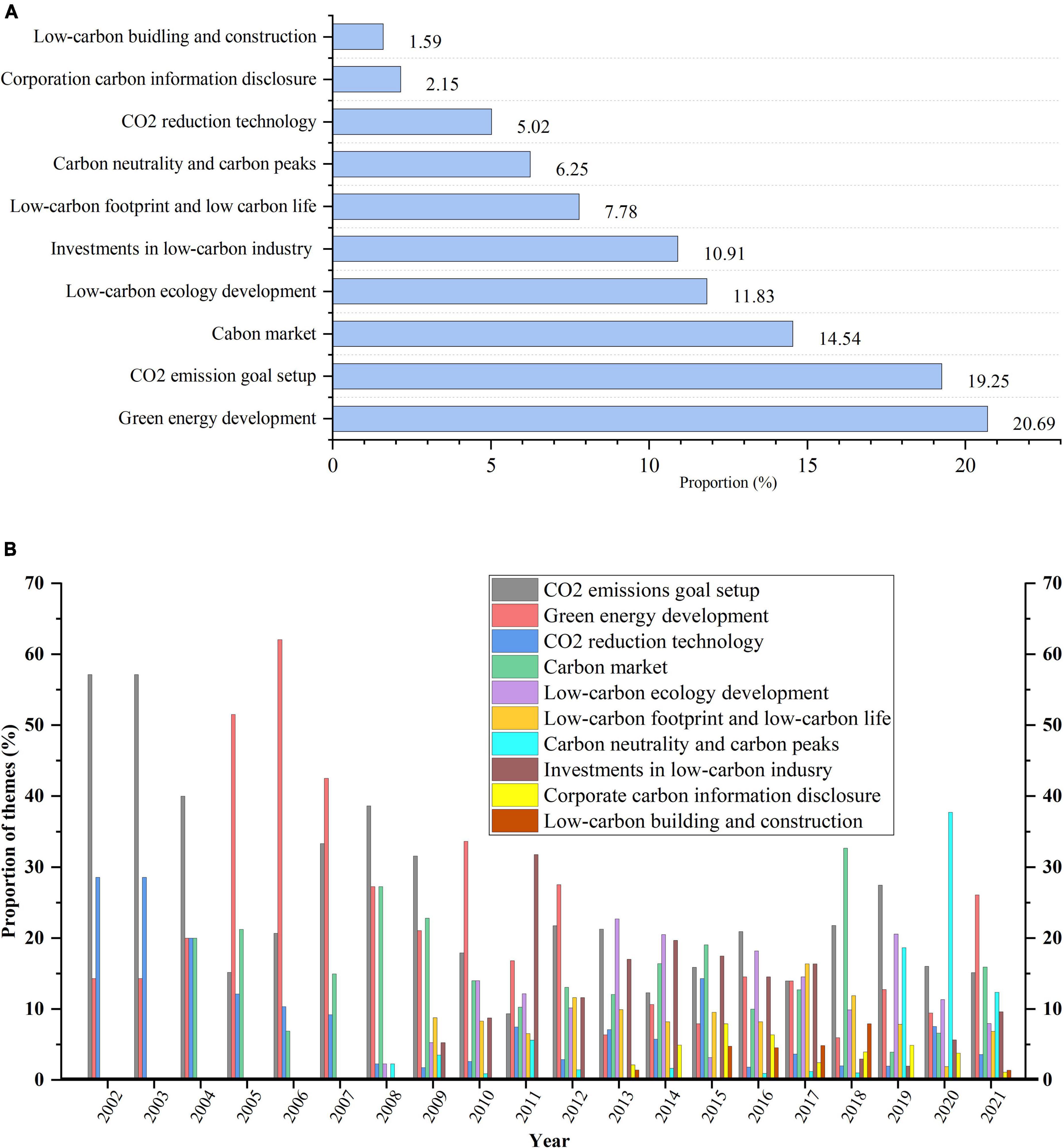
Figure 3. (A) The proportion of theme topics identified as key topics in newspapers from 2002 to 2021. (B) The themes of carbon emission management in the news reports 2002-2021.
Figure 4 shows the nature of major organizations participating in carbon management actions. Government agencies have been the prominent participants and had more than 50% participation in most of the years. These governmental agencies include government units and departments at all levels and regions. No firm or non-governmental organization (NGO) or public participated in carbon emissions management at the beginning stage (2002). Starting from 2003, the participation of firms and NGOs occupied an evident proportion of the management action, though it did not exceed the Government. In 2021, there was a rapid increase in firms’ participation and shared the same proportion with the Government, reflecting the growing importance of firms in participating the carbon emissions management.
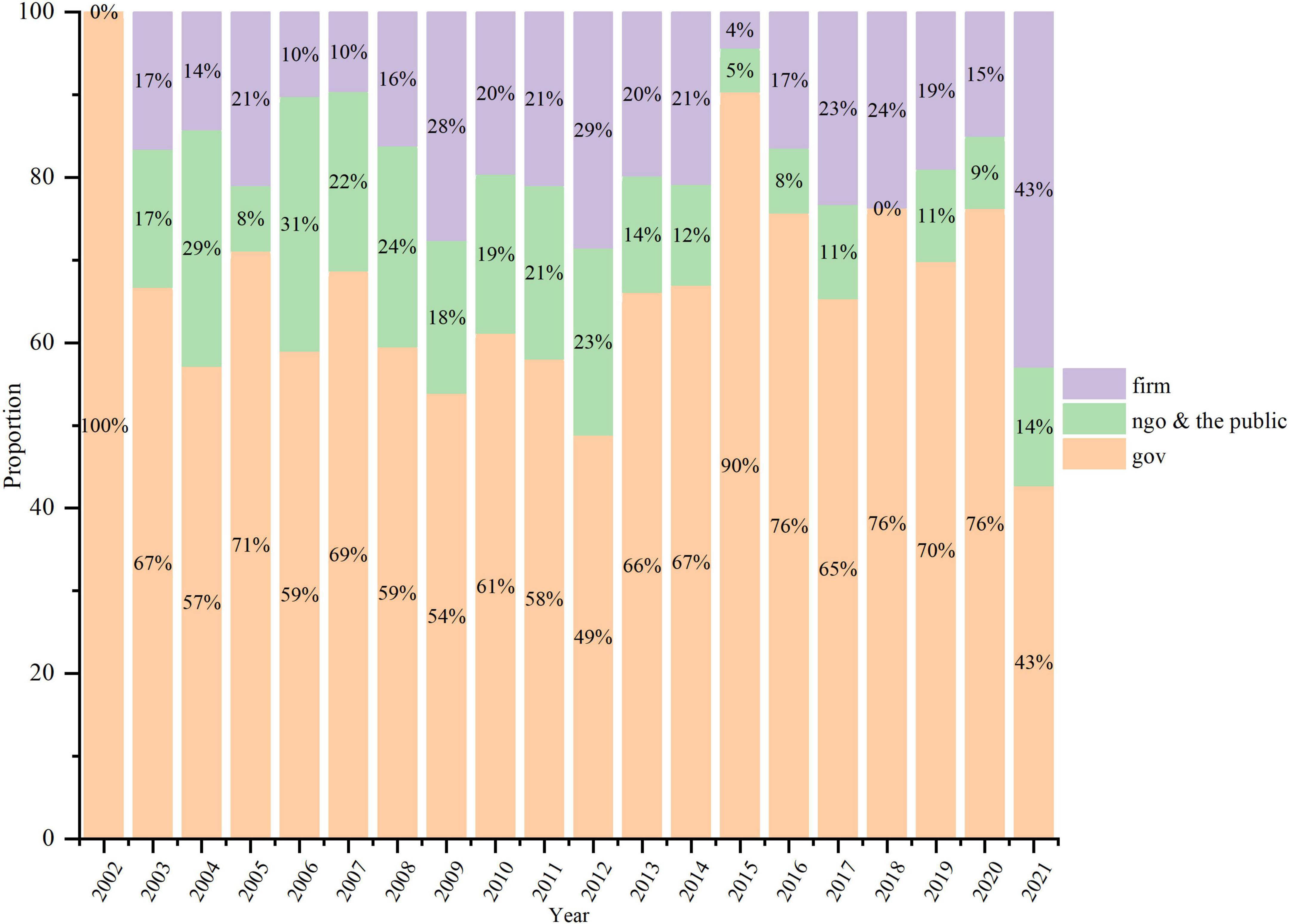
Figure 4. The proportion of different types of organizations and agencies that participate in the carbon emissions management.
Figure 5 demonstrates changes in the proportion of different carbon-related policies and treaties mentioned in the news reports. A regression analysis was performed to determine the trend of change. The results showed that the evolution change follows a sigmoid function, with an adjusted R2 of 0.91 for the international policy, 0.743 for the national policy, and 0.71 for the regional policy. The international policies were dominant at the earliest stage from 2002 to 2006. After 2006, the coverage of international policies in the news reports began to decline and stayed at a low level after 2010 (around 15%). Meanwhile, the proportion of national policies increased with the decrease of the international policies proportion and occupied the dominant part in the following ten years. The regional policy had a continuous growth trend. In 2021, national and regional carbon emission management policies were mostly mentioned in the news reports.
The tone of the reports reflects the government’s attitudes and views on carbon management issues (Figure 6). Obviously, the expression of environmental tones dropped continuously, then stabled at a constant dynamic level after 2010. On the other hand, the tones of economic, social, and technical have risen, but with different trends. The proportion of economic-tone reports increased harshly from 2002 to 2006 then remained fluctuating in a range of 25–40%. The proportion of technical-tone reports was the lowest of the others; it increased sharply after 2002 and reached its peak in 2003. The increase in social tone reports was later than the economic and technical tone reports. The evident increase of proportion was after 2007 and reached the peak of 53% in 2013, and then the proportion dropped and retained a state of great fluctuation (20–45%).
Figure 7 demonstrates the proportion of the carbon emission management actions introduced in each industrial and economic sector. The management behavior of the power (power generation) industry accounted for the largest proportion at that time, reaching 40%, followed by the emission management of “commercial and residential operations.” The “agriculture, forestry and other land-use,” “transportation,” and “manufacturing and industrial production” emission management had a similar proportion. The “Construction and Building” sector was the least concerned, occupying only 3.7% of the total introduced actions.
The spatial differences in carbon emission management in China
The number of carbon emission management actions implemented by provinces (or municipalities) in China is uneven (Figure 8). Beijing, Shanghai, and Guangdong reported the highest number of actions and are also the economic centers and the most developed regions in China. First, Beijing was at the top (more than 100), then followed by Shanghai (≥90). Guangdong had the third-largest number of actions (78). The fourth tier (40–59) includes Jiangsu and Zhejiang, Inner Mongolia, Shanxi, Sichuan, and Tianjin. Then the rest provinces (or municipalities) were in tier five (20–39) and tier six (0-19), of which Guangxi province reported the least number of carbon-related actions. The details are listed in Table 3.
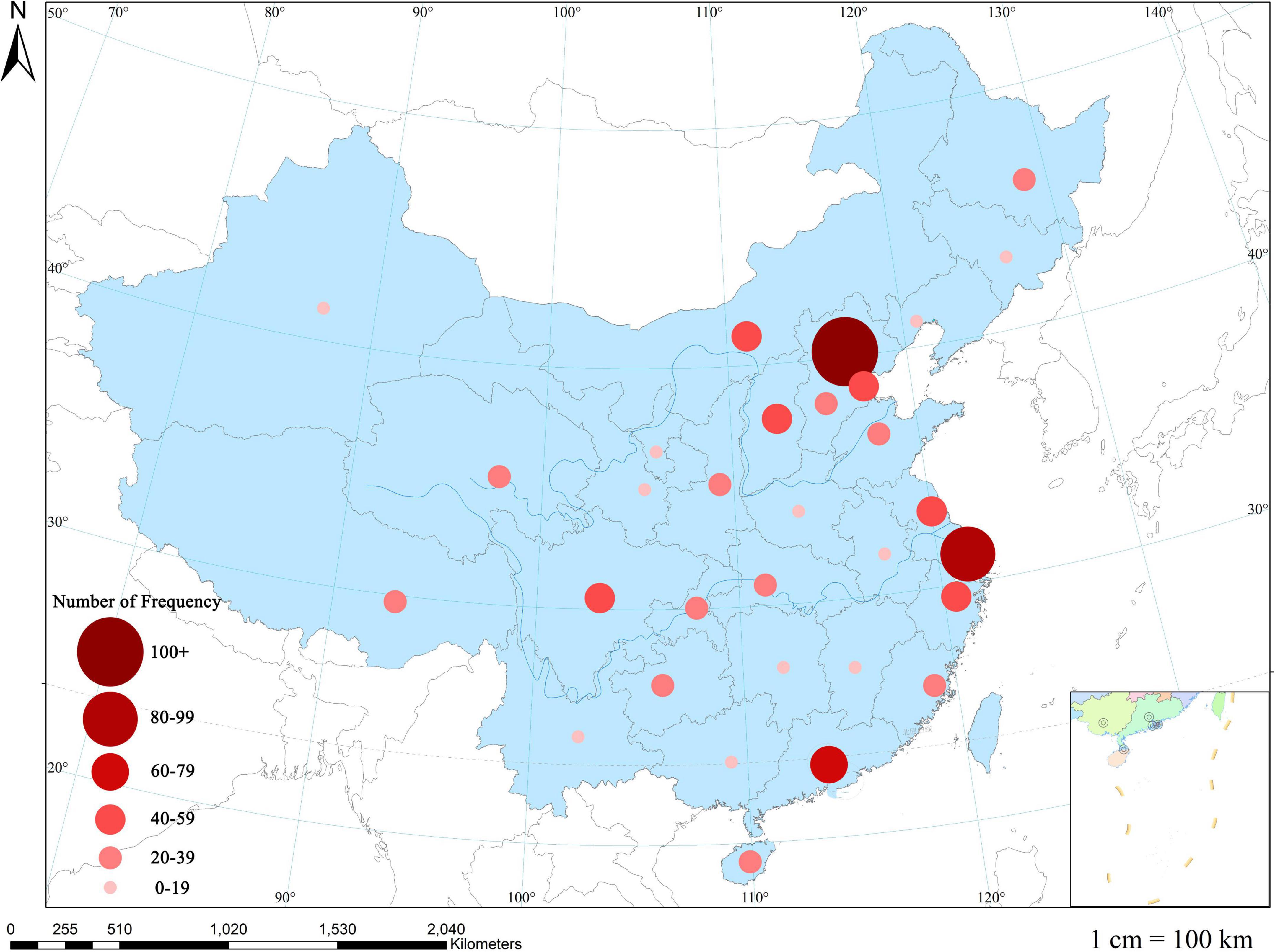
Figure 8. The geographic location in mainland China of carbon emissions management regimes and actions reported in the reports.
Specifically, Figure 9 demonstrates the proportion of the carbon-related economic section in each province (or municipality), reflecting the uniqueness and the unevenness of carbon management actions applied in each place. Evidently, carbon management in the power industry was dominant, especially in Shanxi and Liaoning provinces. Ningxia, Gansu, Xinjiang, and Jilin provinces (>50%) also regarded carbon management in the power industry as a primary action. In the second-largest economic section (Figure 7), commercial operations and residential activity did not account for the same proportions across provinces. Though some provinces have reached a ratio of more than 20% (the highest in Shanghai for 32 there were also some provinces below 10% or even no relevant reports, such as Guangxi, Yunnan, Jilin, Shandong, and Shanxi. In contrast, agricultural and forestry carbon emission management existed in all provinces; it was highly significant in some provinces and exceeded the proportion of the power industry (i.e., Heilongjiang, Tibet, and Inner Mongolia). Carbon management actions in transportation and manufacturing industries were not as dominant as in the power and agriculture sectors, but they occupied a significant proportion in some provinces. In most provinces, carbon emissions management in the construction and building industry was least focused on and had no relative reports. It was reported in only a few provinces but occupied a low proportion (<10%). Tianjin was the only city with a large (32%) share of carbon management in the construction sector.
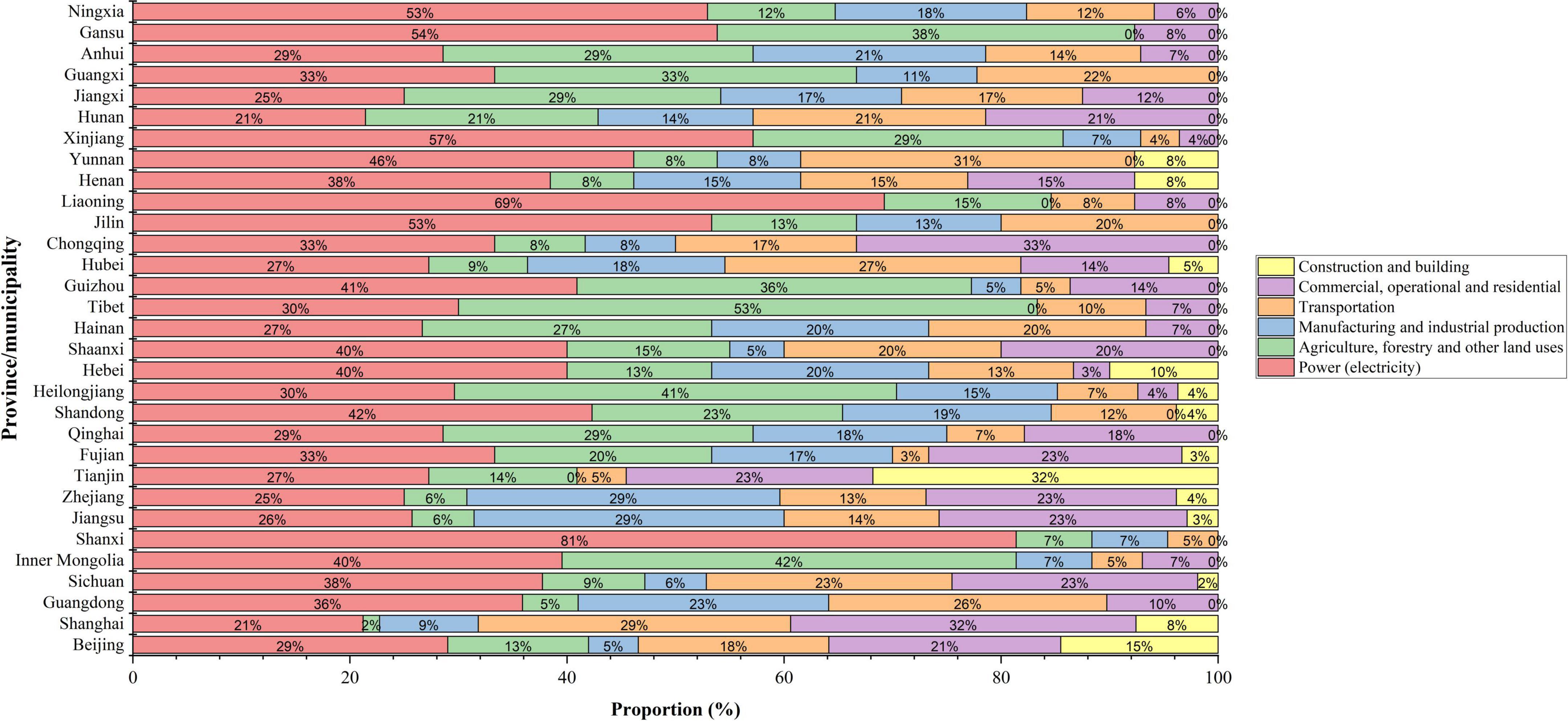
Figure 9. The proportion of carbon emissions management activities and actions in different industry sectors mentioned in the news reports of each province and municipality.
Discussion
It is important to understand the evolution of China’s carbon management-related regimes and actions toward carbon neutrality to be able to explore the strengths and weaknesses in carbon emissions reduction development. This paper develops a new perspective on understanding China’s carbon emissions management regimes using longitudinal empirical study and content analysis of Xinhua News Agency, China’s major official news media The main research results theoretically help regulate the uneven development of China’s emerging carbon-related institutional planning and carbon emission management. The findings and their implication for practices and future research are as follows.
Carbon emissions management issues are relatively prominent in Chinese news media coverage, and the number has generally increased over time. The results show the periodic growth characteristics of the report. The two most prominent years, 2010 and 2021, were milestones in carbon management, corresponding to low-carbon city pilots and carbon-neutral construction, respectively. Since the Chinese Government began implementing concrete carbon management actions in 2010, the number of carbon-related news reports has increased and remained higher than the previous years. In addition, the key findings also show that the theme of the news reports has become diverse since around 2010 (Figure 3B), evolving from low-diversity themes to more diverse and comprehensive themes involving the construction of a low-carbon society Low-carbon economic development, and low-carbon ecology. Thus, 2010 can be regarded as an important time node for carbon emissions management in China. From this node, China introduced concrete actions of national low-carbon construction pilot projects, such as low-carbon transportation and carbon market pilot programs (Khanna et al., 2014; Qu and Liu, 2016). In addition, 2021, as the first year of carbon neutrality in China, will become a new node in the development of carbon management. The increased news reports indicate that carbon management in China has entered a new stage, from pilot city projects to nationwide low-carbon constructions, meaning that more concrete regimes and actions will be implemented in the future.
Furthermore, looking at the composition of policies covered in the report, the number of international policies declined significantly after 2010, replaced by an increasing number of national and regional policies. From passivity to proactivity, domestic actions and policies were intensified, leading to a leadership role on the national stage in 2010 (Garnaut et al., 2018). After 2017, regional policy overtook national policy, maintaining its dominance in 2021. China’s carbon management has transitioned from international learning to national leadership and local implementation. With the advancement of carbon neutrality and national low-carbon plans, it is estimated that the number of local policies will continue to remain at a high level in the future, which is of positive significance for achieving carbon peaking and carbon neutrality goals.
However, the results show that during the decades of China’s low-carbon transition, there are serious development imbalances that are prevalent in different management studies elsewhere (Gobel, 2011; Xin-gang et al., 2014; Lo, 2020; Xiong et al., 2020). First, in terms of the participation of different types of institutions, the Government had higher participation than that of firms, the public, and other non-governmental organizations. This reflects that the carbon management in China is primarily governmental driven and has top-down management characteristics. Previous studies illustrate that firms must emphasize green process innovation and participate in activity implementation to achieve carbon neutrality (Lee, 2021; Zameer et al., 2021). In addition, although the Government plays a role in leading structural change in a stepwise manner, the transition is ultimately chosen and determined by society (Rotmans et al., 2001). Therefore, a high participation and cooperation of firms and the public are necessary. It is remarkable to notice that firms’ participation evidently increased in 2021, which signifies the deepening of cooperation and collaboration between the Government and firms. Nevertheless, this ongoing government-business collaboration needs to be maintained to achieve future carbon peaking and neutrality goals across industry sectors.
Second, there are distinctive differences in carbon management themes and industries. The news reports continue to decline the focus on low-carbon technologies. Achieving carbon neutrality requires technological innovation in sectors of all aspects, such as reforming the current energy and production system and enhancing atmospheric CO2 capture (Wang F. et al., 2021). The results show that the Chinese Government attaches utmost attention to green energy development, for instance, increasing investments in relative industries and implementing more power industry management activities in each province (Figure 9). Since the green energy industry promotes the development of the economy and investment (Naqvi et al., 2022), strengthening green energy development to achieve economic growth and carbon neutrality goals become a top-down consensus among Chinese governments.. Judging from the proportion of other carbon abatement technologies such as carbon fixation, carbon sequestration, and carbon capture, the publicity of these low-carbon technologies did not receive sufficient attention from the Government. This asymmetric reporting of news theme and tone preferences explains that current carbon emission management strategies in most regions of China are biased toward achieving economic and social goals, while partially ignoring technological and environment-related improvements and advocacy (Figure 6). Although the role of renewable energy in promoting carbon emission reduction is more obvious than that of technological innovation, improving green technological innovation cannot be ignored from the perspective of long-term development (Shao et al., 2021b; Su et al., 2022). Therefore, the diversity of carbon reduction technologies should be improved.
Furthermore, the implementation of low-carbon management is uneven across industries and economic sectors (Figure 7). Comparing the results with the sectoral contribution of CO2 emissions in China (Sandalow, 2019), the proportion of low-carbon management in the industrial sector (11.9%) is much lower than its CO2 emissions (50% of total industries). Although it is worth affirming that, the Chinese government implement management actions in major carbon emission sectors, but the uneven allocation of management resources and the lagging low-carbon development in some sectors will hinder the rapid realization of carbon-neutral goals.
Third, regarding geographical distribution, carbon management reporting systems and actions are highly concentrated in the core provinces and cities with the most developed economic and social development in mainland China. Among all the 31 provinces and municipalities, Beijing (131), Shanghai (93), and Guangdong (78) reported a higher number of actions than other provinces. Although this result showed the news coverage of the Xinhua News Agency is nationwide, the asymmetry in the amount of news across provinces illustrates the clear geographic differences and uneven development of carbon emissions management. Specifically, the intensity of carbon management in the eastern and coastal regions of China is higher than in most inland provinces. Moreover, each province’s industry sector proportion is highly different due to each region’s industrial structure characteristics, which may be driven by the regional industrial clustering effect (Zhong et al., 2022). For instance, major energy provinces such as Shanxi and those with abundant ecological resources like Inner Mongolia and Tibet invested more in comparable carbon management actions. However, some provinces did not invest in all the industry sectors, such as the construction and building industries. Therefore, the key conclusion is that the development and implementation of carbon management actions are uneven in quantity and type of industry across regions.
According to these deficiencies, the practical implications of this study are as follows. Initially, cultural construction should be strengthened to promote carbon neutrality. Empirical results of previous studies show that fostering green values and spreading green culture at the micro-level significantly affects carbon neutrality. Specific measures can include creating green hotspots at the macro-level such as promoting the concept of green life, building green cities, creating low-carbon cultural industries, and building green cultural and technological centers and museums (Xiao et al., 2021; Wang et al., 2022). These measures could help establish a top-down green communication system to enhance people’s awareness of green development, advocate green ideas, and increase public participation in constructing a low-carbon society. The Government could fully use the official media’s propaganda capabilities to achieve this goal. Second, the Government should increase low-carbon investment in more industries and fields, including emerging industries such as green tourism (Yue et al., 2021) and neglected and undervalued industrial and economic sectors such as environment-related research and development (R&D) and consumption-based carbon-emitting activities (Su et al., 2020; Shao et al., 2021a). Thirdly, increase investments in low-carbon actions in provinces and municipalities with relative backward carbon management development to reduce the uneven distribution of management resources among regions. These proposals are the adjustments to sensitivities to dynamics and goals of China’s staged low-carbon development. They ensure the coherence and consistency of public policies and help promote the gradual realization of structural changes in China’s carbon management.
The limitations of this study are as follows. Firstly, this study used the primary data from news media, which may not be comprehensive enough to cover all the unevenness and asymmetry factors within the carbon management development in China, such as the specific economic and environmental data. In addition, similar studies could be extended by considering the city/county-level data. Hence, future studies could consider combining relative data sets for quantitative and in-depth analysis of specific uneven issues in China’s carbon management. Moreover, the coding framework could evolve according to the development of carbon management as more carbon-related themes, and emerging industries might be proposed in the future. In conclusion, carbon emissions management in China has developed rapidly and made landmark trials and practices. However, our study indicates that the actions, policies, and regimes implemented throughout the development exist uneven issues in the management themes and preferences, industrial and economic sectors, and between regions. Therefore, it strongly suggests that policymakers could actively use China’s top-down management characteristics and the official media to promote improving relevant laws and measures to formulate the public’s low-carbon concepts, thereby stimulating the achievement of carbon-neutral goals.
Data availability statement
The raw data supporting the conclusions of this article will be made available by the authors, without undue reservation.
Author contributions
RG and KY: writing—original draft, methodology, formal analysis, and research design. CQ: formal analysis and review and editing. YW: formal analysis and review and editing. All authors contributed to the article and approved the submitted version.
Conflict of interest
The authors declare that the research was conducted in the absence of any commercial or financial relationships that could be construed as a potential conflict of interest.
Publisher’s note
All claims expressed in this article are solely those of the authors and do not necessarily represent those of their affiliated organizations, or those of the publisher, the editors and the reviewers. Any product that may be evaluated in this article, or claim that may be made by its manufacturer, is not guaranteed or endorsed by the publisher.
Footnotes
References
Bransford, J. D., Barclay, J. R., and Franks, J. J. (1972). Sentence memory: a constructive versus interpretive approach. Cogn. Psychol. 3, 193–209. doi: 10.1016/0010-0285(72)90003-5
De Vreese, C. H. (2005). News framing: theory and typology. Inf. Des. J. 13, 51–62. doi: 10.1075/idjdd.13.1.06vre
Ducat, D. C., and Silver, P. A. (2012). Improving carbon fixation pathways. Curr. Opin. Chem. Biol. 16, 337–344. doi: 10.1016/j.cbpa.2012.05.002
EPA (2020). Sources of Greenhouse Gas Emissions. Available Online at: https://www.epa.gov/ghgemissions/sources-greenhouse-gas-emissions (accessed May 21, 2022).
Friedlingstein, P., O’Sullivan, M., Jones, M. W., Anew, R. M., Hauck, J., Olsen, A., et al. (2020). Global Carbon Budget 2020. Earth Syst. Sci. Data 12, 3269–3340. doi: 10.5194/essd-12-3269-2020
Gao, R. S., Gao, Q. L., Zhuang, X. L., and Sun, K. Y. (2022). Extending Uppsala Model with Springboard Perspective in Emerging Multinational’s Sequential Internationalisation—Evidence from a Construction Company’s Expansion in Africa. J. Risk Financ. Manag. 15:16. doi: 10.3390/jrfm15010016
Garnaut, R., Song, L., and Fang, C. (2018). China’s 40 Years of Reform and Development: 1978–2018. Canberra: A.N.U. Press.
Geng, Y., Sarkis, J., Ulgiati, S., and Zhang, P. (2013). Measuring China’s Circular Economy. Science 339, 1526–1527. doi: 10.1126/science.1227059
Ghersetti, M. (2014). Still the Same?: comparing news content in online and print media. Journal. Pract. 8, 373–389. doi: 10.1080/17512786.2013.813201
Gobel, C. (2011). Uneven Policy Implementation In Rural China. China J. 65, 53–76. doi: 10.1086/tcj.65.25790557
Herold, M., Goldstein, N. C., and Clarke, K. C. (2003). The spatiotemporal form of urban growth: measurement, analysis and modeling. Remote Sens. Environ. 86, 286–302. doi: 10.1016/S0034-4257(03)00075-0
Hickman, L., Thapa, S., Tay, L., Cao, M., and Srinivasan, P. (2022). Text Preprocessing for Text Mining in Organizational Research: review and Recommendations. Organ. Res. Methods 25, 114–146. doi: 10.1177/1094428120971683
Hong, J. (2011). From the World’s Largest Propaganda Machine to a Multipurposed Global News Agency: factors in and Implications of Xinhua’s Transformation Since 1978. Polit. Commun. 28, 377–393. doi: 10.1080/10584609.2011.572487
Hu, X., Sun, Y., Liu, J., Meng, J., Wang, X., Yang, H., et al. (2019). The impact of environmental protection tax on sectoral and spatial distribution of air pollution emissions in China. Environ. Res. Lett. 14:54013. doi: 10.1088/1748-9326/ab1965
Hua, G., Cheng, T. C., and Wang, S. (2011). Managing carbon footprints in inventory management. Int. J. Prod. Econ. 132, 178–185. doi: 10.1016/j.ijpe.2011.03.024
Joshi, A. D., Patel, D. A., and Holdford, D. A. (2011). Media coverage of off-label promotion: a content analysis of U.S. newspapers. Res. Soc. Adm. Pharm. 7, 257–271. doi: 10.1016/j.sapharm.2010.06.003
Kavanaugh, A. L., Fox, E. A., Sheetz, S. D., Yang, S., Li, L. T., Shoemaker, D. J., et al. (2012). Social media use by Government: from the routine to the critical. Gov. Inf. Q. 29, 480–491. doi: 10.1016/j.giq.2012.06.002
Khanna, N., Fridley, D., and Hong, L. (2014). China’s pilot low-carbon city initiative: a comparative assessment of national goals and local plans. Sustain. Cities Soc. 12, 110–121. doi: 10.1016/j.scs.2014.03.005
Kim, H., Jang, S. M., Kim, S.-H., and Wan, A. (2018). Evaluating Sampling Methods for Content Analysis of Twitter Data. Soc. Media Soc. 4:205630511877283. doi: 10.1177/2056305118772836
Lee, H. (2021). Is carbon neutrality feasible for Korean manufacturing firms?: the CO2 emissions performance of the Metafrontier Malmquist–Luenberger index. J. Environ. Manag. 297, 113235–113235. doi: 10.1016/j.jenvman.2021.113235
Liu, N., Ma, Z., Kang, J., and Su, B. (2019). A multi-region multi-sector decomposition and attribution analysis of aggregate carbon intensity in China from 2000 to 2015. Energy Policy 129, 410–421. doi: 10.1016/j.enpol.2019.02.015
Liu, Z., Deng, Z., He, G., Wang, H., Zhang, X., Lin, J., et al. (2021). Challenges and opportunities for carbon neutrality in China. Nat. Rev. Earth Environ. 3, 141–155. doi: 10.1038/s43017-021-00244-x
Lo, K. (2020). Ecological civilization, authoritarian environmentalism, and the eco-politics of extractive governance in China. Extr. Ind. Soc. 7, 1029–1035. doi: 10.1016/j.exis.2020.06.017
Mallapaty, S. (2020). How China could be carbon neutral by mid-century. Nature 586, 482–483. doi: 10.1038/d41586-020-02927-9
Marks, D. (2010). China’s Climate Change Policy Process: improved but still weak and fragmented. J. Contemp. China 19, 971–986. doi: 10.1080/10670564.2010.508596
Mccombs, M. E., and Shaw, D. L. (1972). The agenda-setting function of mass media. Public Opin. Q. 36, 176–187. doi: 10.1086/267990
McHugh, M. L. (2012). Interrater reliability: the kappa statistic. Biochem. Med. 22, 276–282. doi: 10.11613/BM.2012.031
Munnings, C., Morgenstern, R. D., Wang, Z., and Liu, X. (2016). Assessing the design of three carbon trading pilot programs in China. Energy Policy 96, 688–699. doi: 10.1016/j.enpol.2016.06.015
Musa, S. D., Zhonghua, T., Ibrahim, A. O., and Habib, M. (2018). China’s energy status: a critical look at fossils and renewable options. Renew. Sustain. Energy Rev. 81, 2281–2290. doi: 10.1016/j.rser.2017.06.036
Naqvi, B., Rizvi, S. K. A., Hasnaoui, A., and Shao, X. (2022). Going beyond sustainability: the diversification benefits of green energy financial products. Energy Econ. 111, 106111. doi: 10.1016/j.eneco.2022.106111
Nawaz, M. A., Hussain, M. S., Kamran, H. W., Ehsanullah, S., Maheen, R., and Shair, F. (2020). Trilemma association of energy consumption, carbon emission, and economic growth of BRICS and OECD regions: quantile regression estimation. Environ. Sci. Pollut. Res. Int. 28, 16014–16028. doi: 10.1007/s11356-020-11823-8
O’Connor, C., and Joffe, H. (2020). Intercoder reliability in qualitative research: debates and practical guidelines. Int. J. Qual. Methods 19, 1–13. doi: 10.1177/1609406919899220
Perdan, S., and Azapagic, A. (2011). Carbon trading: current schemes and future developments. Energy Policy 39, 6040–6054. doi: 10.1016/j.enpol.2011.07.003
Potter, W. J. (2011). Conceptualizing Mass Media Effect. J. Commun. 61, 896–915. doi: 10.1111/j.1460-2466.2011.01586.x
Qiao, D., Yuan, W., and Ke, S. (2021). China’s Natural Forest Protection Program: evolution, Impact and Challenges. Int. For. Rev. 23, 338–350. doi: 10.1505/146554821833992811
Qu, Y., and Liu, Y. (2016). Evaluating the low-carbon development of urban China. Environ. Dev. Sustain. 19, 939–953. doi: 10.1007/s10668-016-9777-8
Rotmans, J., Kemp, R., and van Asselt, M. (2001). More evolution than revolution: transition management in public policy. Foresight 3, 15–31. doi: 10.1108/14636680110803003
Russell Neuman, W., Guggenheim, L., Mo Jang, S., and Bae, S. Y. (2014). The Dynamics of Public Attention: agenda-Setting Theory Meets Big Data. J. Commun. 64, 193–214. doi: 10.1111/jcom.12088
Saravade, V., Chen, X., Weber, O., and Song, X. (2022). Impact of regulatory policies on green bond issuances in China: policy lessons from a top-down approach. Clim. Policy 1–12. doi: 10.1080/14693062.2022.2064803 [Epub ahead of print].
Shao, X., Zhong, Y., Liu, W., and Li, R. Y. M. (2021b). Modeling the effect of green technology innovation and renewable energy on carbon neutrality in N-11 countries? Evidence from advance panel estimations. J. Environ. Manag. 296, 113189–113189. doi: 10.1016/j.jenvman.2021.113189
Shao, X., Zhong, Y., Li, Y., and Altuntaş, M. (2021a). Does environmental and renewable energy R and D help to achieve carbon neutrality target? A case of the U.S. economy. J. Environ. Manag. 296, 113229–113229. doi: 10.1016/j.jenvman.2021.113229
Stemler, S. (2001). An overview of content analysis. Pract. Assess. Res. Eval. 7, 1–16. doi: 10.7275/z6fm-2e34
Su, C.-W., Naqvi, B., Shao, X.-F., Li, J.-P., and Jiao, Z. (2020). Trade and technological innovation: the catalysts for climate change and way forward for COP21. J. Environ. Manag. 269, 110774–110774. doi: 10.1016/j.jenvman.2020.110774
Su, C. W., Pang, L. D., Tao, R., Shao, X., and Umar, M. (2022). Renewable energy and technological innovation: which one is the winner in promoting net-zero emissions? Technol. Forecast. Soc. Change 182:121798. doi: 10.1016/j.techfore.2022.121798
Umar, M., Ji, X., Kirikkaleli, D., Shahbaz, M., and Zhou, X. (2020). Environmental cost of natural resources utilization and economic growth: can China shift some burden through globalization for sustainable development? Sustain. Dev. 28, 1678–1688. doi: 10.1002/sd.2116
Van der Wurff, R. (2008). “The Impact of the Internet on Media Content,” in The Internet and the Mass Media, eds L. Küng, R. G. Picard, and R. Towse (London: SAGE Publications Ltd), 65–85.
Wang, F., Harindintwali, J. D., Yuan, Z., Wang, M., Wang, F., Li, S., et al. (2021). Technologies and perspectives for achieving carbon neutrality. Innovation 2:100180. doi: 10.1016/j.xinn.2021.100180
Wang, K.-H., Umar, M., Akram, R., and Caglar, E. (2021). Is technological innovation making world “Greener”? An evidence from changing growth story of China. Technol. Forecast. Soc. Change 165:120516. doi: 10.1016/j.techfore.2020.120516
Wang, X., Huang, J., and Liu, H. (2022). Can China’s carbon trading policy help achieve Carbon Neutrality? — A study of policy effects from the Five-sphere Integrated Plan perspective. J. Environ. Manag. 305, 114357–114357. doi: 10.1016/j.jenvman.2021.114357
Wang, Y., Song, Q., He, J., and Qi, Y. (2015). Developing low-carbon cities through pilots. Clim. Policy 15, S81–S103. doi: 10.1080/14693062.2015.1050347
Wei, J., Wei, Y., Tian, F., Nott, N., de Witt, C., Guo, L., et al. (2021). News media coverage of conflict and cooperation dynamics of water events in the Lancang–Mekong River basin. Hydrol. Earth Syst. Sci. 25, 1603–1615. doi: 10.5194/hess-25-1603-2021
Wei, J., Wei, Y., and Western, A. (2017). Evolution of the societal value of water resources for economic development versus environmental sustainability in Australia from 1843 to 2011. Glob. Environ. Change 42, 82–92. doi: 10.1016/j.gloenvcha.2016.12.005
Wei, J., Wei, Y., Western, A., Skinner, D., and Lyle, C. (2015). Evolution of newspaper coverage of water issues in Australia during 1843–2011. Ambio 44, 319–331. doi: 10.1007/s13280-014-0571-2
Weng, Q., and Xu, H. (2018). A review of China’s carbon trading market. Renew. Sustain. Energy Rev. 91, 613–619. doi: 10.1016/j.rser.2018.04.026
Xiao, J., Zhen, Z., Tian, L., Su, B., Chen, H., and Zhu, A. X. (2021). Green behavior towards low-carbon society: theory, measurement and action. J. Clean. Prod. 278:123765. doi: 10.1016/j.jclepro.2020.123765
Xin, X. (2006). A developing market in news: xinhua News Agency and Chinese newspapers. Media Cult. Soc. 28, 45–66. doi: 10.1177/0163443706059285
Xin-gang, Z., Tian-tian, F., Lu, C., and Xia, F. (2014). The barriers and institutional arrangements of the implementation of renewable portfolio standard: a perspective of China. Renew. Sustain. Energy Rev. 30, 371–380. doi: 10.1016/j.rser.2013.10.029
Xiong, N., Wong, S. W., Ren, Y., and Shen, L. (2020). Regional Disparity in Urbanizing China: empirical Study of Unbalanced Development Phenomenon of Towns in Southwest China. J. Urban Plan. Dev. 146:5020013. doi: 10.1061/(ASCE)UP.1943-5444.0000586
Xiong, Y., Wei, Y., Zhang, Z., and Wei, J. (2016). Evolution of China’s water issues as framed in Chinese mainstream newspaper. Ambio 45, 241–253. doi: 10.1007/s13280-015-0716-y
Yang, W., Zhao, R., Chuai, X., Xiao, L., Cao, L., Zhang, Z., et al. (2019). China’s pathway to a low carbon economy. Carbon Balance Manag. 14:14. doi: 10.1186/s13021-019-0130-z
Yang, Y., and Cheng, L. (2017). Operational efficiency evaluation and system design improvements for carbon emissions trading pilots in China. Carbon Manag. 8, 399–415. doi: 10.1080/17583004.2017.1387033
Yue, X.-G., Liao, Y., Zheng, S., Shao, X., and Gao, J. (2021). The role of green innovation and tourism towards carbon neutrality in Thailand: evidence from bootstrap ADRL approach. J. Environ. Manag. 292, 112778–112778. doi: 10.1016/j.jenvman.2021.112778
Zameer, H., Wang, Y., Vasbieva, D. G., and Abbas, Q. (2021). Exploring a pathway to carbon neutrality via reinforcing environmental performance through green process innovation, environmental orientation and green competitive advantage. J. Environ. Manag. 296, 113383–113383. doi: 10.1016/j.jenvman.2021.113383
Zamith, R., and Lewis, S. C. (2015). Content Analysis and the Algorithmic Coder: what Computational Social Science Means for Traditional Modes of Media Analysis. Ann. Am. Acad. Polit. Soc. Sci. 659, 307–318. doi: 10.1177/0002716215570576
Zhang, J., Terrones, M., Park, C. R., Mukherjee, R., Monthioux, M., Koratkar, N., et al. (2016). Carbon science in 2016: status, challenges and perspectives. Carbon 98, 708–732. doi: 10.1016/j.carbon.2015.11.060
Zhao, X., Ma, X., Chen, B., Shang, Y., and Song, M. (2022). Challenges toward carbon neutrality in China: strategies and countermeasures. Resour. Conserv. Recycl. 176:105959. doi: 10.1016/j.resconrec.2021.105959
Zheng, H., Song, M., and Shen, Z. (2021). The evolution of renewable energy and its impact on carbon reduction in China. Energy 237:121639. doi: 10.1016/j.energy.2021.121639
Zhong, Y. F., Gao, R. S., and Yue, X.-G. (2022). Home Countries Matter for the Internationalisation of Emerging Market Multinational Enterprises. J. Risk Financ. Manag. 15:46. doi: 10.3390/jrfm15020046
Keywords: news media report, carbon neutrality, content analysis, evolution, uneven policy implementation
Citation: Gao R, Yang K, Qin C and Wan Y (2022) Using media reports to analyze the spatio-temporal evolution of carbon dioxide management development in China. Front. Ecol. Evol. 10:968108. doi: 10.3389/fevo.2022.968108
Received: 13 June 2022; Accepted: 07 July 2022;
Published: 04 August 2022.
Edited by:
Xuefeng Shao, University of Newcastle, AustraliaCopyright © 2022 Gao, Yang, Qin and Wan. This is an open-access article distributed under the terms of the Creative Commons Attribution License (CC BY). The use, distribution or reproduction in other forums is permitted, provided the original author(s) and the copyright owner(s) are credited and that the original publication in this journal is cited, in accordance with accepted academic practice. No use, distribution or reproduction is permitted which does not comply with these terms.
*Correspondence: Kunshu Yang, kunshu.yang@uqconnect.edu.au
 Ruosu Gao
Ruosu Gao Kunshu Yang
Kunshu Yang Chuan Qin
Chuan Qin Yunshan Wan
Yunshan Wan